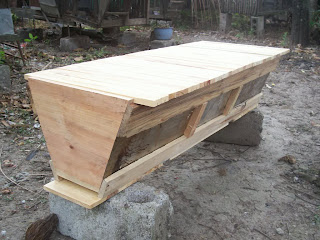Top-Bar Beekeeping 101: Sustainable Beekeeping in St. Mary, Jamaica
 |
| Example of a top-bar hive. |
Why top-bar?
Mr. Hebert's host and Yerba Buena Farm Owner, Agape Adams, explains the difficulty of obtaining foundation for traditional Langstroth hives in Jamaica.
"In America, any beekeeper can purchase as many sheets of foundation as they need to increase the number of hives they have in their apiary. In Jamaica, it is not so easy. In order to get foundation, beekeepers must bring in wax to exchange for an equal weight of foundation. In order to grow, farmers raid wild hives and use the wax they remove to exchange for extra foundation. It’s not an easy or sustainable situation."
 |
| Tom Hebert and his homemade smoker. |
Through Mr. Hebert's trainings, Agape, her husband Kwao, and other interested local beekeepers hope to learn a more natural, affordable method of beekeeping. In addition to lower material costs, they look forward to not having to raid wild hives for wax to exchange for foundation. As expressed by Agape, "the list of advantages is long".
To prepare for Mr. Hebert's arrival, his hosts have set up 8, hand-made trap hives using wood from their bamboo trees and purchased a Langstroth hive for demonstrations on converting Langstroth hives to top-bar. Mr. Hebert plans on leading two workshops each weekend - one for novices and one for advanced beekeepers. He hopes to also bring in Field Officers from the Apiculture Unit as well as members of the All-Island Bee Farmer’s Association for these trainings. Workshop topics include: bee development and bee biology; colony organization; best places to locate hives; what hives need; hive construction; swarm removal; apiary management; integrated pest management; and harvesting. For those not completely ready to transition to top-bar hives, he'll provide instruction on simplified Langstroth management and transferring comb from top-bar to frame hives.
Mr. Hebert will use his time during the week to make sample gloves and veils, produce a sample foundation mold and other visuals for his training on equipment construction, and pay visits to individual apiaries for 1-on-1 consultations.

.png)

Comments
Post a Comment